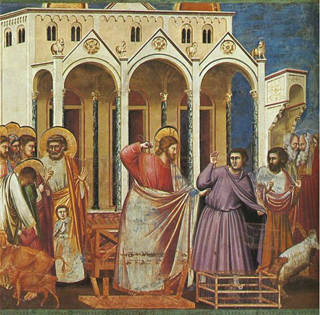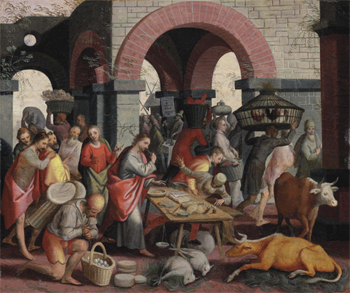For Sunday March 4, 2018
The Third Sunday of Lent
Lectionary Readings (Revised Common Lectionary, Year B)
Exodus 20:1-17
Psalm 19
1 Corinthians 1:18-25
John 2:13-22
Not long ago, I came across a hymn that stopped me in my tracks. Composed by Brian Wren, it’s entitled “Good is the Flesh,” and its lyrics are as follows:
Good is the flesh that the Word has become,
good is the birthing, the milk in the breast,
good is the feeding, caressing and rest,
good is the body for knowing the world,
Good is the flesh that the Word has become.Good is the body for knowing the world,
sensing the sunlight, the tug of the ground,
feeling, perceiving, within and around,
good is the body, from cradle to grave,
Good is the flesh that the Word has become.Good is the body, from cradle to grave,
growing and aging, arousing, impaired,
happy in clothing, or lovingly bared,
good is the pleasure of God in our flesh,
Good is the flesh that the Word has become.Good is the pleasure of God in our flesh,
longing in all, as in Jesus, to dwell,
glad of embracing, and tasting, and smell,
good is the body, for good and for God,
Good is the flesh that the Word has become.
“Good is the flesh” was not a phrase I grew up hearing in church. Much less “milk in the breast” or “glad of embracing, and tasting, and smell.” Though I learned early on that the Incarnation is central to Christian orthodoxy, I did not learn to link that doctrine to actual bodies, actual flesh. Much less did I learn to honor the sacred in skin, limbs, muscles, and hair — mine or anyone else’s.
| |
But that is precisely what Jesus does in this week’s Gospel reading, when he brandishes a whip, overturns the tables of the money changers, drives out the sheep and cattle, and dares his listeners to “destroy this temple.” They misunderstand, of course, and assume that Jesus is referring to the Herodian temple they’re standing in. But no, St. John insists in his Gospel. Jesus isn’t referring to edifices built of stone or brick or wood. The home of the transcendent is not a courtyard, a parapet, or an altar. Rather, God resides in a different kind of temple altogether — the temple of Jesus’s own body.
During this Lenten season, I’m thinking and praying a lot about what it means to honor human bodies — mine, yours, everyone’s — as holy places. As homes for God. It’s not an easy thing to do in a religious culture that too often views the body as inherently sinful, shameful, and spiritually dangerous. Neither is it easy to do in a secular culture that commodifies the body, cheapening it for the sake of profit. Most of the time, I see my own body as something to shrink, conquer, or tame. I see its flaws so much more clearly than I see its God-ordained dignity and beauty. Rarely — so rarely — do I see it as a vehicle for worship, love, hospitality, and grace.
And yet if St. John is telling us something essential about where and how we might find God, we are people of the Incarnation in the truest sense, called to look, to see, to break bread, share wine, and wash feet. How can we learn to see our embodied lives, our sensory lives, our physical lives, as fully implicated in our lives with God? How can we move past contempt, squeamishness, and fear, and offer God our whole selves? How can we welcome “the pleasure of God in our flesh?”
 |
In this week’s Gospel story, there is a high cost involved in honoring human flesh as the home of the divine. What Jesus calls out when he “cleanses” the temple is not Judaism or its various forms of worship. It is a system of exploitation via exorbitant tithes and taxes that blocks access to the divine — that literally keeps the bodies of the poor outside the gates of the temple, forcing them into more and endless debt before they can approach and worship God.
In her book, An Altar in the World, Barbara Brown Taylor writes that it is not possible to lean into God’s love for my body, without simultaneously recognizing that God loves “all bodies everywhere.” The “bodies of the hungry children and indentured women along with the bodies of sleek athletes and cigar-smoking tycoons.” “One of the truer things about bodies,” Taylor concludes, “is that it is just about impossible to increase the reverence I show mine without also increasing the reverence I show yours.” In other words, once I value my own body as God’s temple, as a site of God’s pleasure, delight, and grace, how can I stand by while other bodies suffer exploitation, poverty, discrimination, or abuse?
Apparently, Jesus could not. He interrupted worship for the sake of justice. He moved from compassion to righteous anger to decisive action, because he would not stand for the violation of sanctuary. He would not tolerate blocked access to his Father's house. He would not stomach any version of unfairness and cruelty towards the most vulnerable and beleaguered people in his society.
We don't hear much about anger in mainline churches these days. After all, there's something unseemly about rage, right? Something unsophisticated, something crude? It's not polite to get angry, and it's positively insupportable to stay angry. But Jesus — the temple of God — burned with zeal for his Father’s house. He didn’t use love and forgiveness as palliatives; he allowed a holy anger to move him to action on behalf of the helpless and the voiceless. In this story, there is nothing godly about responding to systemic evil with passive acceptance or unexamined complicity. If human bodies are really temples — holy places where heaven and earth meet — then we must work, as Jesus did, to preserve and protect these holy places from every form of irreverence and desecration. We must let go of the comfortable belief that our highest calling as Christians is to niceness.
But this cannot happen if we keep our faith lives tethered at the level of intellectual abstraction. If we live a Christianity of the mind without also living one of the flesh. After all, it is with our bodies that we experience deep pain, deep anger, deep terror, and deep joy. It’s my chest that hurts when I mourn. It’s my face that burns when I’m angry. It’s my whole body that warms with pleasure when I’m happy.
 |
In her widely influential essay, “The Power of Anger in the Work of Love,” Beverly Harrison writes: “The important point is that where feeling is evaded, where anger is hidden or goes unattended, masking itself, there the power of love, the power to act, to deepen relation, atrophies and dies.”
Where, I’m asking myself during this Lenten season, has my power to act, to deepen relationship, or to love fiercely, atrophied? Where has my faith become so abstract, so disembodied, that I no longer find it natural or easy to rejoice with those who rejoice, or mourn with those who mourn?
Good is the flesh that the Word has become. Do we believe this? Do we believe it enough to honor bodies — all bodies — as precious temples of God? We dare not say “yes” glibly, because as John Dominic Crossan reminds us, the cost involved is steep: “Those who live by compassion are often canonized. Those who live by justice are often crucified.” No, it’s not either-or. It’s both-and; we are called to both compassion and justice. But as Symeon the New Theologian expressed it so eloquently a thousand years ago, it is our love for Christ's body that will compel us to both:
For if we genuinely love Him,
we wake up inside Christ’s bodywhere all our body, all over,
every most hidden part of it,
is realized in joy as Him,
and He makes us, utterly, real,and everything that is hurt, everything
that seemed to us dark, harsh, shameful,
maimed, ugly, irreparably
damaged, is in Him transformedand recognized as whole, as lovely,
and radiant in His light
he awakens as the Beloved
in every last part of our body.
Image credits: (1) The Archives Near Emmaus; (2) Wikipedia.org; and (3) Wikipedia.org.



